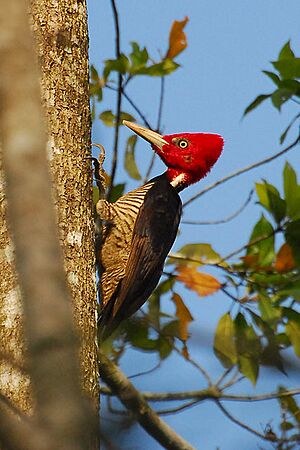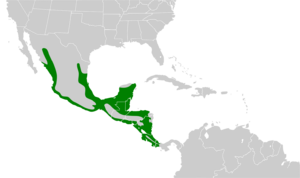Pale-billed woodpecker facts for kids
Quick facts for kids Pale-billed woodpecker |
|
|---|---|
 |
|
| Male | |
| Conservation status | |
| Scientific classification | |
| Genus: |
Campephilus
|
| Species: |
guatemalensis
|
 |
|
The pale-billed woodpecker (Campephilus guatemalensis) is a cool bird from the woodpecker family. You can find it living in forests from Mexico all the way down to Panama. It's known for its bright colors and its strong bill, which it uses to find food.
Contents
Meet the Pale-billed Woodpecker
The pale-billed woodpecker has a scientific name, Campephilus guatemalensis. Scientists have found that there are three slightly different types, called subspecies. Think of them like different breeds of dogs, but for birds!
- C. g. regius
- C. g. nelsoni
- C. g. guatemalensis
What Does a Pale-billed Woodpecker Look Like?
This woodpecker is a fairly large bird. It can be about 35.5 to 38 centimeters (14 to 15 inches) long. Some of them weigh around 263 to 282 grams (9.3 to 9.9 ounces). Others are a bit lighter, weighing 205 to 244 grams (7.2 to 8.6 ounces).
Colors and Markings
Most pale-billed woodpeckers have black feathers on their upper body, from their neck to their back. They have cool white or light yellow stripes on the sides of their neck. These stripes continue onto their back, often forming a "V" shape.
Their tail is a dull brown color. Their wings are mostly black. The throat and upper chest are also black. The rest of their belly is a light yellowish color with thin black stripes.
Special Features
One of the most noticeable things about this bird is its bill. It's long, strong, and looks like a chisel. It's a pale ivory yellow color. Their eyes are a light cream-yellow, and their legs are greenish-gray.
Males, Females, and Young Birds
Adult male woodpeckers have a bright red head with a fluffy crest of feathers. Sometimes they have a grayish-brown spot near their ear.
Adult females look a bit different. They have black feathers on the front and top of their head. Their throat is also black.
Young woodpeckers look a lot like the adult females. However, their bill is darker, and the sides of their head are mostly dull black.
Subspecies Differences
The C. g. nelsoni subspecies is a little smaller than the main type. Its black feathers are more brownish. The stripes on its upper body are whiter. It might also have some brown and black stripes on its lower back.
The C. g. regius subspecies is larger than the main type. But other than its size, it looks quite similar.
Where Do Pale-billed Woodpeckers Live?
These woodpeckers live in different parts of Central America.
- C. g. regius lives in eastern Mexico.
- C. g. nelsoni lives in western Mexico.
- C. g. guatemalensis lives from southern Mexico all the way through Belize, Guatemala, El Salvador, Honduras, Nicaragua, and Costa Rica into western Panama.
Their Favorite Homes
Pale-billed woodpeckers like to live inside and on the edges of many kinds of forests. They especially love lowland tropical evergreen forests. These are forests where trees stay green all year.
In drier areas, they can also be found in tropical forests where trees lose their leaves. They even live in mangrove forests, which are found near coastlines. Sometimes, you can spot them in mountain forests or pine-oak forests.
They do not like large areas where all the trees have been cut down. They prefer places with lots of big trees. You can find them from sea level up to about 2,000 meters (6,500 feet) high, depending on the country.
Pale-billed Woodpecker Behavior
Movement
These woodpeckers don't migrate. They stay in the same area all year long.
What Do They Eat?
Pale-billed woodpeckers usually look for food in the middle and upper parts of trees. But sometimes, they will search on the ground, looking at tree stumps and fallen logs.
They find their food by digging into rotten wood or peeling bark off dead trees. They usually search for food alone or in pairs. They don't usually join other types of birds when they are looking for food.
Their main food is believed to be large larvae (young insects) of wood-boring beetles. They also eat termites and some small fruits.
Reproduction and Life Cycle
We don't know everything about when pale-billed woodpeckers have their babies. It seems to depend on where they live. In southern Mexico, they might breed between December and June. In Costa Rica, it's between August and September.
Both the male and female woodpeckers work together to dig a nest hole. They usually make it in a large, often dead, tree. These nests are typically 3 to 12 meters (10 to 39 feet) above the ground.
A female woodpecker usually lays two eggs. Both parents take turns sitting on the eggs to keep them warm. We don't know exactly how long the eggs take to hatch or when the young birds leave the nest.
Sounds and Calls
The pale-billed woodpecker has a special call that sounds like a "nasal chatter or sputter." People describe it as sounding like a "squeeze toy" saying "kip kip kip kip-hey'eh'eh."
They also make other sounds, like "low whining notes" or a "loud 'bleating' call." When they drum on trees, it's a loud, fast double tap. Sometimes, but not often, they make a long series of up to seven quick taps.
Is the Pale-billed Woodpecker Safe?
The IUCN (International Union for Conservation of Nature) says the pale-billed woodpecker is a species of "Least Concern." This means they are not currently in danger of disappearing.
They live across a very large area. Scientists think there are at least 50,000 adult birds, but this number might be going down. No big threats have been found right now.
However, these woodpeckers need large trees to find their food. They will leave areas that have been deforested or where too many trees have been cut down. In Mexico, these woodpeckers are listed as needing "special protection" by a local law.


